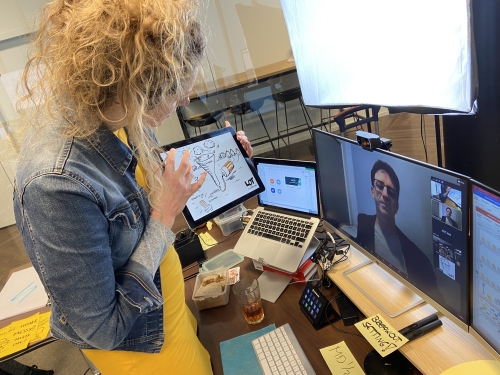The assignment
Who? Eighty employees living across all continents.
What? Aligning and shaping cultural values, behaviour, internal communication, collaboration, preventing overtime and restoring the work-life balance of individuals.
When? The working conference lasted 12 hours over three consecutive days and was organised in Zoom.
The big question: How do you spend this time online with such a group of people in a useful way on a non-tangible subject like culture and behaviour? What went well and what did we learn from it? And yes, we will also be honest about a few things that could be done better.
Facilitating an online conference with several people works very well
Peter Shields is a leadership coach, born, raised and living in Sydney. He is my age and loves to surf. I met him a few weeks ago when we were asked to co-lead this conference. We had a great personal rapport and I felt that two captains on the virtual ship was really necessary. While Peter focused on the content of culture and behaviour, I was mainly concerned with the energy in the group, timing, explaining the working methods, the online presentations and facilitating brainstorming sessions. A job in itself. I wouldn't have want to do it alone. And neither did he. In fact, there were more of us. Lot Bakker was present full time for graphic recording and visualising the main outcomes of the team sessions. And our colleague Joline supported us in all Zoom-related matters, such as arranging break-outs, monitoring the chat box and making recordings.
The visual bonus
Aside from our role in facilitating (online) conferences and workshops, we are also known for using visualisation in everything we do. Hence the prominent role of visualisation in this assignment. We have used the power of imagination and the use of drawing as an activity in different ways. On day one, Lot put everything that was said on one big sheet. The second day was all about making team plans. Because we believe that a picture is worth a thousand words, and a metaphor more than a thousand pictures, we encouraged the teams to think in metaphors. Lot made a digital drawing for each team that clearly shows how the team sees itself and what their role is in the organisation. Their jaws dropped when the teams presented their drawings to each other and shared their vision of what they represent as a team.
Frequent informal break-out sessions in small groups ensured connection
Plenary sessions with eighty people online can cost more energy than they yield. Unless you hear a fascinating talk or experience a presentation like this. And that is exactly what we did. We kept the plenary sessions as short as possible and we often came up with a reason for participants to do something in break-out sessions. One of the MT members underlined this: 'people are dying to just meet each other and connect on a personal level'. We also used drawing in these activities, by letting the participants visualise the different cultural values themselves. Visualisation was seen as a different language, and as we heard afterwards, it brought interaction, fun and excitement to the conversation. It is precisely these kinds of informal activities and the use of visual language that contributed to the success of the conference.
Group assignments with visual templates and instructions
Every facilitator knows that giving simple and clear explanations is important. Again, I noticed that this is even more true in online situations. Crystal clear assignments and templates are crucial. The reason for this: there is usually little time for the assignment. In addition, it is difficult for break-out facilitators to contact the session leader for help.
Good preparation helps. We prepared the following for the facilitators of the break-out sessions:
- A short instruction sheet explaining the purpose of the break-out and what to look out for to ensure that everything runs smoothly. We call this a cheat-sheet.
- An online template provided in an online PowerPoint document. Lot had drawn the template by hand, which we placed in the background of the presentation.
Despite good preparation, the clear template and the cheat sheet, there is always room for improvement. Afterwards, we received feedback that the time allowed for this assignment was very short. From the hour scheduled, only half an hour remained because participants had been given extra time to catch up in informal break-out sessions. That’s a point for improvement right there!
The balance between group processes, the energy and the content of the conference remains something to keep an eye on. Good preparation and planning helps. However, unexpected things always happen and things do not always go as planned. Responding well to this is the art. And fortunately, we succeeded again.
In the meantime, we have been asked to assist this organisation again next year with an online conference. You don't get better feedback, do you? Hopefully our experiences will help you in organising a large online meeting. More tips? Check out our book The World of Visual Facilitation or sign up for the training Effective Online Meetings. We are very curious about what you do when you want to achieve results with a (large) group online.
We love to hear from you!




